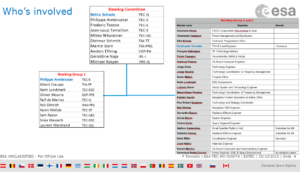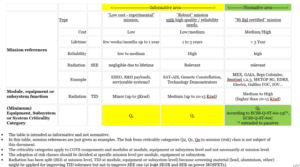Guidelines for using COTS Components
- Posted by Ferdinando Tonicello
- On December 3, 2019
- 0
This presentation address the guidelines for COTS components and equipment or subsystems of different criticality categories for ESA.
WHY COTS COMPONENTS AND MODULES IN SPACE?
- Cost advantage, only for large volumes or low reliability/low radiation application where important risks might be taken.
- Performance advantage not obtainable by classical Hi-Rel components
- Lack of Hi-Rel components for performing that function
- Availability of production capability of supply chain for terrestrial use
- Shorter lead times
ESA’s Initiative on COTS

Output
- Interim report to the ESA Executive Board (presented 29 Oct 2019) with set of recommendations for the use of COTS in future Agency programmes/“new space”, plus a roadmap/ required next steps to achieve them
- Final report to the ESA Executive Board (to be prepared by Q1 2020)
Who’s involved

WG tasks
WG1
-
- Definition of the COTS EEE components perimeter for space.
- What is available/industrial landscape? – Normative landscape?
- Where do we use COTS today?
- How do we use COTS today?
- Current best practices and lessons learned.
WG 2/3
-
- Perform the classification of the COTS component categories according to (applications) risk classes;
- Identify procurement, screening, application and test methods for COTS components and modules in the different application risk classes;
- Identify a roadmap of the necessary R&D (and other) activities to finalise the proposed COTS components and modules approach.
WG 2/3 finalised a TN
- Set of guidelines and not requirements
- Balanced approach especially between reliability and radiation performances, according to a progressive scheme from higher to less risk taking
- Addressing the issue of small procurement lots and relevant lot homogeneity issues
- Addressing the application of COTS parts in modules, equipment or subsystems of different criticality categories for ESA institutional missions.
Projected advantage: on a given mission, different criticality categories can appear, depending on the nature of the considered modules, equipment or subsystem.
Example: essential vs experimental or “expendable” item.
Classification of criticality categories

Critical aspects coverage
For each criticality category Q2, Q1, Q0 the following aspects are addressed:
-
- Perimeter of application
- Methods to resolve the critical points relevant to
- RAMS (Safety, dependability, FMECA…)
- Material and processes
- EEE components general issues
- Radiation (TID, TNID, SEE)
- Economy of scale/supply chain
- Application, including
approaches for data sheets review, electrical analyses needs, mitigation techniques, reference application circuits, modules
Recommended activities to finalize the proposed COTS components and modules approach
- Update of ECSS-Q-ST-60-13C
- This activity is running, ESA participates through TEC-QES (Requirements and Standards) and TEC-EDC (EEE components).
- Identification of safe operation factors for criticality categories Q2 and Q1
- Proposed ESA focal points: TEC-QEC (radiation), TEC-EDC (EEE components).
- COTS components and modules, information gathering
- Proposed ESA focal points: TEC-QEC (radiation), TEC-EDC (EEE components).
- Reference application circuits
- Proposed ESA focal points: TEC-ED (digital components), TEC-EPM (power and analogue components)
- New test methods for modules and boards
- Proposed ESA focal points: TEC-QEC (radiation) and TEC-EDC (EEE components)
- Lead free recommendations
- Proposed ESA focal points: TEC-MSP (Materials & Processes), TEC-EDC (EEE components), TEC-QEE (Materials’ Physics & Chemistry)
- Good practices for Radiation
- Proposed ESA focal point: TEC-EPS (Space Environment and Effects)
- Guidelines for using COTS Components - December 3, 2019


0 comments on Guidelines for using COTS Components